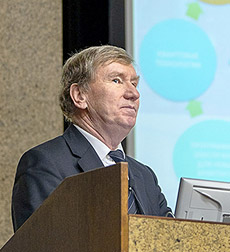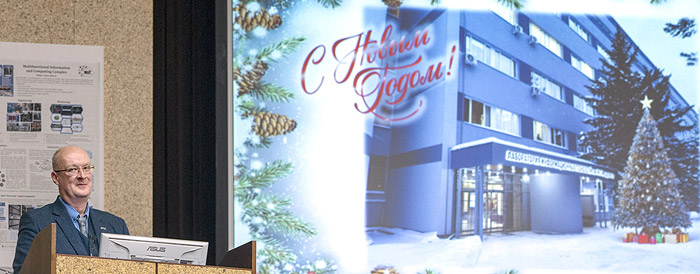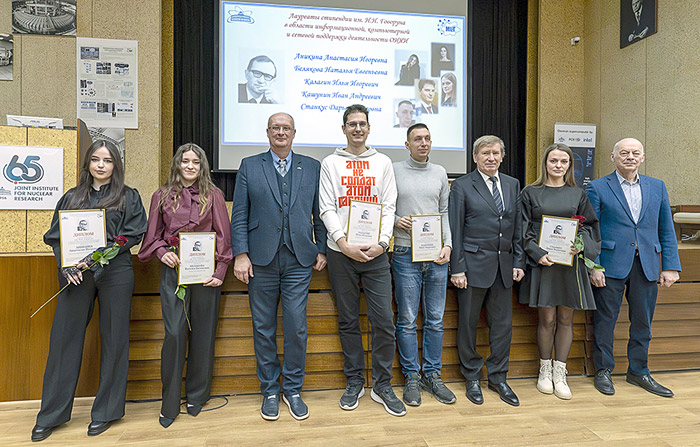
Electronic english version since 2022 |
The newspaper was founded in November 1957
| |
|
Number 1 (4749) |
Institute day by day
MLIT: results of 2024 and plans for 2025
On 27 December, a festive meeting of the staff of the Meshcheryakov Laboratory of Information Technologies dedicated to summing up the results of MLIT activities in 2024 was held.
Opening the meeting, JINR Director Grigory Trubnikov emphasized that thanks to the initiative of MLIT, a good tradition has been established to hold final seminars in the Laboratories of the Institute. They have already been held in various ways at FLNR, FLNP and DLNP, gathering full halls, with Directors of other Laboratories present. It is very important for the staffs of the Laboratories to know about what has been done over the year. "The crowning glory of these Laboratory meetings is the final meeting at MLIT. I would like to thank you for the year, a very difficult year. The pace that the Institute maintains impresses our colleagues in different countries, at CERN, GSI, GANIL. I would like to highlight your contribution to maintaining JINR's information links. You have a friendly, young staff, a good management staff, the best example of a fusion of generations, mutual respect for employees of all categories, ages and nationalities. You are our main information portal, an information platform. You support science and bring the Laboratories of the Institute closer together through data. "Digital JINR" is a very important area, it helps to live and work. And the fact that its founder S. D. Belov defended his thesis is very important. Thank you for your results, work, talents. I wish everyone peace, stability, health in the new year and for the Laboratories to increase with employees, especially from the Member States," Grigory Trubnikov wished everyone.
Kind words and congratulations to the Laboratory staff were expressed by JINR Scientific Leader Victor Matveev and JINR Vice-Director Vladimir Kekelidze.
 MLIT Scientific Leader Vladimir Korenkov summed up the year, focusing on two areas: the MICC infrastructure project and the digital ecosystem that is the foundation of not only the Laboratory, but also of the Institute; as well as the MICC engineering infrastructure that ensures its successful functioning. All MICC components - Tier1 and Tier2 centres, the Govorun supercomputer and the cloud infrastructure are well-conditioned and are very popular with users not only from JINR, but also from around the world. "We join all our resources into a single environment that allows us to meet serious tasks: processing LHC data or the NICA complex, which we are completely ready to start working for," the speaker emphasized.
MLIT Scientific Leader Vladimir Korenkov summed up the year, focusing on two areas: the MICC infrastructure project and the digital ecosystem that is the foundation of not only the Laboratory, but also of the Institute; as well as the MICC engineering infrastructure that ensures its successful functioning. All MICC components - Tier1 and Tier2 centres, the Govorun supercomputer and the cloud infrastructure are well-conditioned and are very popular with users not only from JINR, but also from around the world. "We join all our resources into a single environment that allows us to meet serious tasks: processing LHC data or the NICA complex, which we are completely ready to start working for," the speaker emphasized.
This time, he focused on the engineering infrastructure. In 2024, the MICC power supply was modernized and special tools were developed to improve it. At the end of the year, a lot of equipment was obtained that was installed and launched by the team headed by A.G.Dolbilov and A.S.Vorontsov. The condition of our large farm should be constantly monitored, this is what the monitoring system is aimed at. It includes equipment of different years that we would like to update and completely automate.
MLIT worked on the network infrastructure together with colleagues from the Kurchatov Institute National Research Centre that according to Vladimir Korenkov, played the leading role in the duet. Today, KI no longer needs a channel to CERN and MLIT decided not to give it up and to take all the worries upon itself. In addition to external communication channels, a multi-cluster network with a throughput of 4x100 Gbit/s operates between VBLHEP and MLIT. The JINR Tier1 centre is the first in the world in providing experiments on CMS. With 27% of the total CPU operating time, MLIT has overtaken centres in FNAL and European countries. The Tier2 centre currently provides the users of JINR and of virtual organizations of the grid environment of the LHC, NICA and other experiments with computing power and storage systems, as well as access to data. The JINR Tier2 website is the most productive in the Russian grid segment. In 2024, the cloud infrastructure developed and was widely used primarily by the neutrino platform - the Baikal GVD, JUNO, NOvA experiments. Vladimir Korenkov complained about the lack of a direct communication channel with China. This is one of the main issues that needs to be addressed immediately. And of course, the star of the MLIT infrastructure is the Govorun supercomputer that is constantly upgraded. Today, it is used in the NICA megaproject, for calculating lattice quantum chromodynamics, the properties of superheavy element atoms, research in the field of radiation biology and for calculating the radiation safety of JINR facilities. The supercomputer, included in the unified supercomputer infrastructure based on the National Research Computer Network of Russia (NIKS) is in high demand, the range of tasks met on it constantly expands.
The monitoring system should be qualitatively changed, it should not only be operational monitoring, but also analysis and forecasting. A special hierarchical data processing and storage system with software-defined architecture was developed and implemented at Govorun. "It is important that we can unite all resources for large projects into a single distributed heterogeneous environment based on the DIRAC platform," Vladimir Korenkov emphasized. One of the areas is the development of a software package for developing digital twins of distributed centres for accumulating, storing and processing data, very important first of all for NICA, as well as for Russian centres for data management in LHC experiments and Russian mega-projects. This area, according to the speaker, should be expanded and distributed to the whole infrastructure of the Institute. Since Russian centres are no longer participating in LHC experiments, it is very important that the whole infrastructure of the centres that participated in processing LHC data turns to processing Russian mega-projects, primarily, NICA. The RDIG Russian consortium should be transformed into RDIG-M for the development of a distributed computer infrastructure uniting key centres that participate in mega-science projects. Its core should be a consortium for IT support of mega-science projects developed on the basis of JINR, the Kurchatov Institute National Research Centre and the Institute of System Programming of the Russian Academy of Sciences.
The speaker highlighted the significance of improving the Institute's digital ecosystem (DES). This year, a major step was made in its development. By the end of the year, PIN-2 (S.V.Kunyaev's team) and the second project - a publication repository (I.A.Filozova's team), implementing the prompt data acquisition of the JINR employees' research papers from various sources were prepared for commissioning. Much should be done in this area in 2025, preparations are to be made for the transfer of procurement processes to the document management system developed by DDSD, for digitization of laboratory buildings and for other tasks.
MLIT annually holds spring and autumn student schools on information technologies, the MPQIT International Conference was successfully held and one of the largest in its field, the International Conference on Mathematical Modeling and Computational Physics was held at the highest level in Yerevan for the first time this year.
"I would like to congratulate D.I.Pryakhina and S.D.Belov that successfully defended their PhD theses in December. A total of 15 theses were defended in the MLIT Dissertation Council. On 16 December, a license was otained for a new educational master's programme at the Moscow State University branch in Dubna in the field of "Applied Mathematics and Computer Science" - "Methods and technologies for data processing in heterogeneous computing environments". Starting next year, we will start preparing masters for ourselves!" Vladimir Korenkov concluded his speech.

"Let's see what we've achieved over the year and where we should move next," MLIT Director Sergey Shmatov started his report. He recalled that 2024 is the first year of the new Seven-Year Plan and the modified Topical Plan, in which MLIT is represented by the MICC project, which Vladimir Korenkov spoke about in detail and of Theme 05-6-1119-2014, aimed at developing mathematical methods, algorithms and software for simulation of physical processes and experimental facilities, processing and analyzing experimental data.
This year, the Laboratory staff published almost 150 scientific papers, 3 monographs, about 100 articles in the framework of international collaborations, presented more than 140 reports at Russian and international conferences. The priority goal of this Theme consists of large research projects of JINR, in which MLIT organizes and provides computational support for the preparation and implementation of the physical research programme carried out at JINR and other research centres with the participation of the Institute; development and advancement of mathematical techniques and software for simulating physical processes and experimental facilities, processing and analysis of experimental data in the field of elementary particle physics, nuclear physics, neutrino physics, radiobiology and others. Research is carried out in three areas: simulation of physical processes and facilities; data inferring and analysis; development of appropriate software. The data analysis and processing system is successfully implemented on the DIRAC platform. In parallel, an alternative system based on the PANDA platform is currently developed, the prototype of which was successfully launched and tested this year. At the same time, a system for primary processing of SPD OnLine Filter experiment data is currently developed. The development of information systems and databases within the ATLAS experiment (CERN) is carried out and in order to transfer them to the NICA project, a decision has been made to establish a special group on databases. MLIT Director highlighted development of algorithms and software for inferring charged particle trajectories as a very important area and presented three different experiments as examples. This is a hybrid tracking system of the BM@N experiment. Two approaches are very interesting: one is based on the use of artificial intelligence techniques - based on the Siamese DNN for the SPD experiment. When using the ACTS package for the tracking task in MPD, encouraging results were obtained. In the identification of charged particles, the approach on the GBDT decision trees gives promising results and the MPDROOT platform itself is developed at the same time. In 2004, four releases were issued, during the preparation of which all the main packages were completely updated.
In the simulation of physical processes and data analysis, two striking results were obtained for the RUN2 LHC CMS experiment - on the search for dark matter and the search for resonance in 28 GeV. The review report did not cover the analysis of open LHC data, the development of systems for processing and analyzing data from the Baikal-GVD experiment, cluster search algorithms in SPD and much more. Very interesting results were obtained in various tasks using computational physics techniques to study complex systems. Sergey Shmatov focused on the Laboratory's work in the field of life sciences. This is the use of artificial intelligence to identify plant diseases, to search for and to analyze soil pollution, the use of the HybriLIT platform to develop web services for behavioral tests of laboratory animals and the detection and analysis of radiation-induced foci. Cooperation with BLTP develops in the field of simulating Josephson junctions on the ML/DL/HPC ecosystem of the HybriLIT platform and in other areas; computer simulation of radiation conditions at the NICA accelerator complex will be introduced that is extremely important work.
The Laboratory carries out scientific and technological cooperation with 43 scientific and educational organizations in 20 countries, 52 centres in 22 cities of Russia. MLIT employs 318 people, including 62 Candidates of Science and 21 Doctors, the average age is 53.4 years. In 2024, 14 employees came to work in MLIT.
As the main results of the outgoing year, Sergey Shmatov highlighted: further modernization of the MICC; the beginning of the reconfiguration of the network infrastructure; development of distributed systems for processing and analyzing experimental data at the NICA complex; outstanding results in the development of mathematical methods for meeting nonlinear tasks, simulating complex physical systems; further improvement of the laboratory infrastructure; development of the Centralized Economic System; an influx of personnel.
He also announced plans for 2025: readiness to obtain and process MPD experiment data; modernization of the MICC (expansion of the Govorun supercomputer, others); elaboration of the concept of network infrastructure development and resource aggregation within the RDIG-M consortium and cooperation with Russian and foreign centres; development of various systems, techniques and algorithms, of the digital ecosystem; attraction of new employees.
"2025 is an important year for us. With the results and the mood we finish it, with such a mood we will meet 2026, the year of the 60th anniversary of MLIT and the 70th anniversary of JINR," Sergey Shmatov concluded.

Olga TARANTINA,
photo by Alexey VORONTSOV